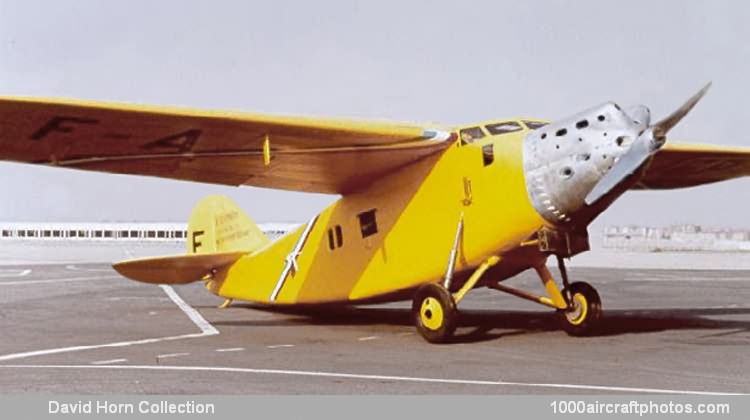09/30/2012. Remarks by Johan Visschedijk: "Établisements Adolphe Bernard was formed in April 1917, being dissolved in 1922, but reappeared in 1924 as the Société Industrielle des Métaux et du Bois (SIMB), also referred to as Bernard SIMB. The company was closed in 1926, but the new Société des Avions Bernard was established in late 1927.
The first models of the new company was the high-wing monoplane Type 19 (a development of the SIMB 18T). Designed by Jean Galtier in 1927, it was a high-wing cantilever monoplane of wooden construction and conventional configuration, and a prototype was built in 1928. Intended for commercial long distance flights, the type could be fitted with different engines. With a 480 hp Gnome & Rhône license-built Bristol Jupiter engine it became the model 190 T, and eight examples were sold to CIDNA (Compagnie internationale de navigation aérienne), while with a 450 hp Lorraine-Dietrich engine it became the model 197.
Probably the best know version is the record-breaking model 191 GR (Grand Raid), fitted with a 500 hp Hispano-Suiza V-engine, of which three examples were produced. Painted all-red and named France, the first 191 GR was used by Louis Coudouret (pilot) and Louis Mailloux (navigator) in an unsuccessful attempt to cross the North Atlantic in August 1928. On July 7, 1929, Coudouret was killed when the aircraft crashed near Angoulême, some 75 mls (120 km) north-east of Bordeaux, France.
The second all-yellow 191 GR, named Oiseau Canari (Canary Bird), completed the first successful French aerial crossing of the North Atlantic. It was transported by ship to the USA, where it was registered as NC9422. Crewed by Jean Assolant, René Lefebvre and Armand Lotti, the aircraft departed Old Orchard Beach, Maine on June 13, 1929, and after 29 hrs 52 min landed at Comillas, Spain; en route the crew discovered a stowaway, the American journalist Arthur Schreiber. Later it was registered
F-AJGP; presently it is on display in the Musée de l'Air et de l'Espace in Paris.
The third 191 GR, also painted all red, was used by Antoine Paillard to set two world airspeed records, including the one on November 20, 1928 for 1,000 km and a 1,000 kg payload, with an average speed of 138.905 mph (223.546 km)."
